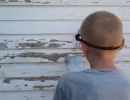Tips on how to use a power paint sprayer—a tool that can make painting large areas much faster and easier—including how to use a power paint sprayer safely and effectively.
Though the debate continues over whether a spray-painted finish is as durable as one that has been painted or rolled on, there is no disputing that using a power sprayer is a real time saver.
Sprayers are a particular convenience for surfaces that would be difficult to paint otherwise, such as shingle siding, latticework, and other surfaces that are textured or have multiple planes.
When you use a paint sprayer, you must meticulously protect surrounding surfaces with plastic and dropcloths. And do not even consider using a sprayer outdoors if it is even a little breezy. Also follow these tips:
• Practice on a large disposable surface to achieve a uniform spray with the least amount of pressure. Make adjustments until the setting is right.
• Spray the surface straight-on in overlapping strips with the gun about a foot away. Move the sprayer smoothly, about 3 inches per second. When you get to the end of a strip, release the trigger and then engage it again as you reverse direction, taking care not to swing your arm. A steady hand and a consistent pace will produce an even coat.
• Do not take longer than 15-minute breaks or the paint in the sprayer will begin to harden. And when you do take a break, set the safety lock. If you must take a longer break, or you are done for the day, clean the paint from the sprayer after turning off and unplugging the unit.
• Pay attention to all recommendations posted with the sprayer. Always wear safety gear, including gloves and goggles, and protective clothing such as a durable long-sleeve shirt and long pants. A respirator is essential gear because paint is airborne. A paint sprayer is a powerful tool—if a jet from a paint sprayer hits a part of the body, it can drive the paint underneath the skin.








 Don Vandervort writes or edits every article at HomeTips. Don has:
Don Vandervort writes or edits every article at HomeTips. Don has:




